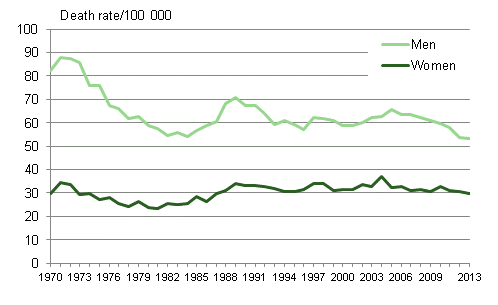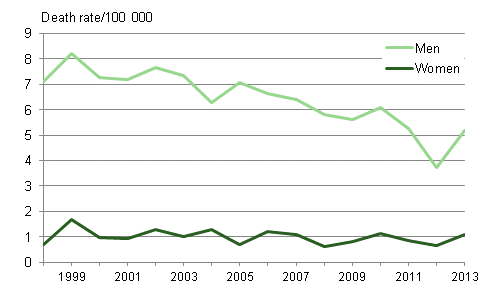5. Stumbling the commonest reason for fatal accidents
Fatal accidents include such as fatal traffic accidents, fatal falls and stumbles, drowning, fatal fires and poisonings. In this publication, all other poisonings apart from alcohol poisonings that belong to alcohol-related causes are considered accidents.
In 2013, accidents caused good four per cent of all deaths. Accidents were the cause of the death of 2,200 persons, of whom 1,400 were men and 800 women. Women's accident mortality is clearly lower than men's but the accident mortality of both sexes has developed favourably in recent years. The lower mortality is mainly due to a decrease in the number of fatal traffic accidents.
Examined by age group, six out of ten persons who died from accidents in 2013 were aged over 65. Aged people died in particular from fatal stumbling and falls more than other age groups.
Figure 8. Accident mortality in 1970 to 2013

The commonest accident leading to death is stumbling or falling. In 2013, stumbling and falling caused the death of over 1,100 persons, which is nearly one-half of all accidental deaths. Approximately one-half of stumbling accidents took place inside one's home or in its immediate vicinity and one-fifth in care institutions. Eight out of ten stumbles resulting in death occurred to persons aged over 65. In absolute numbers, more deaths occurred among elderly women than elderly men but relative to the number of living people, elderly men had more stumbles resulting in death than women in relative terms.
The second most common fatal accidents were transport accidents. There were 281 deaths in transport accidents (excl. drowning accidents in water traffic) in 2013. The number of deaths has decreased by one-third over the past ten years. In 2013, there were, however, nearly 40 more deaths caused by transport accidents than in the year before.
Drowning accidents usually include drowning from falling into water and drowning while swimming or boating. In 2013, a total of 168 persons died in drowning accidents of which 37 in water traffic. Over 80 per cent of those who drowned were men. Men's drowning deaths decreased clearly in a few previous years but the figures became gloomier again in 2013 (Figure 9).
In 2013, the number of deaths in accidental fires was record low. Fires claimed 47 lives, while in 2012 the number of victims was 84. Of these three out of four were men. There were 44 deaths caused by the heat of sauna and 64 deaths caused by hypothermia.
Figure 9. Mortality from drowning accidents 1998 to 2013

More than one-half of the persons that died in fires were intoxicated.
In 2013, alcohol was a contributing factor in one in six fatal accidents, on average. Eighteen per cent of persons that died in fatal accidents were intoxicated, i.e. 355 persons (Appendix table 2). Ten years ago, the corresponding proportion was 23 per cent of fatal accidents. In fatal accidents, intoxication means that the doctor signing the death certificate mentions that alcohol had contributed to the death. The figures exclude alcohol and drug poisonings where alcohol or drugs have not directly caused the death.
In 2013, intoxication was most common in accidental fires. More than one-half of the persons that died in fires were under the influence of alcohol. Also, among sauna deaths and accidental drowning deaths, nearly one-half of the persons were intoxicated. Of those who died of hypothermia, almost two-thirds were sober. In traffic deaths, one in five were intoxicated at the time of death. By contrast, in stumbling accidents, of which a majority occurred among persons aged over 70, only one in ten were under the influence of alcohol.
Four out of five persons that died accidentally from drugs were men.
In 2013, there were 201 deaths in Finland that were caused by drugs. When calculating drug-related deaths, Statistics Finland uses a classification (Selection B) compiled by the European Monitoring Centre for Drugs and Drug Addiction (EMCDDA) that publishes statistics and reports on its Internet site: www.emcdda.europa.eu
According to the EMCDDA, cases where the underlying cause of death is drug psychoses, accidental poisoning, self-inflicted poisoning, and poisoning with undetermined intent are calculated as drug-related deaths. Deaths caused by drug psychoses are usually a result of drug addiction and long-term drug use. Accidental drug poisonings are cases where the death occurs shortly after the consumption of the substance. They can often also be referred to as overdoses. Self-inflicted poisonings with drugs are suicides. In 2013, thirty-three suicides were committed with drugs. In poisonings with undetermined intent, the intent remains unclear.
Table 3. Drug-related mortality 2000 to 2013
| Total | Males | Females | Total | Males | Females | |
| Number | Number | Number | Per 100 000 mean population | Per 100 000 mean population | Per 100 000 mean population | |
| 2000 | 134 | 109 | 25 | 2,6 | 4,3 | 0,9 |
| 2001 | 110 | 78 | 32 | 2,1 | 3,1 | 1,2 |
| 2002 | 97 | 69 | 28 | 1,9 | 2,7 | 1,1 |
| 2003 | 101 | 76 | 25 | 1,9 | 3,0 | 0,9 |
| 2004 | 135 | 96 | 39 | 2,6 | 3,8 | 1,5 |
| 2005 | 126 | 95 | 31 | 2,4 | 3,7 | 1,2 |
| 2006 | 138 | 107 | 31 | 2,6 | 4,2 | 1,2 |
| 2007 | 143 | 116 | 27 | 2,7 | 4,5 | 1,0 |
| 2008 | 169 | 120 | 49 | 3,2 | 4,6 | 1,8 |
| 2009 | 175 | 130 | 45 | 3,3 | 5,0 | 1,7 |
| 2010 | 156 | 117 | 39 | 2,9 | 4,4 | 1,4 |
| 2011 | 197 | 156 | 41 | 3,7 | 5,9 | 1,5 |
| 2012 | 213 | 161 | 52 | 3,9 | 6,1 | 1,9 |
| 2013 | 201 | 148 | 53 | 3,7 | 5,5 | 1,9 |
The drugs referred to in the EMCDDA's classification are mainly opioids. In addition to opioids, drugs also refer to cannabis and cannabinoids, other hallucinogens, and stimulants suitable for abuse, such as amphetamine and its derivatives. In 2013, more than one-half of drug-related deaths were associated with accidental overdoses of opioids.
The numbers of deaths have been calculated in accordance with the WHO's recommendation based on the substance judged as most influential. In many cases, the death is the result of multiple substance poisoning where the person has also taken other substances like alcohol and/or psychopharmacons.
Considerably fewer women than men die from drugs. In 2013, the share of women among all drug-related deaths was one-quarter. One-fifth of the persons that died accidentally from drugs were women but in suicides committed with drugs, the share of women is clearly higher, over one-half. Most drug-related deaths in absolute numbers occurred among persons aged 30 to 34.
Source: Causes of death, Statistics Finland
Inquiries: Airi Pajunen 029 551 3605, Jari Hellanto 029 551 3291, kuolemansyyt@stat.fi
Director in charge: Riitta Harala
Updated 30.12.2014
Official Statistics of Finland (OSF):
Causes of death [e-publication].
ISSN=1799-5078. 2013,
5. Stumbling the commonest reason for fatal accidents
. Helsinki: Statistics Finland [referred: 25.12.2025].
Access method: http://stat.fi/til/ksyyt/2013/ksyyt_2013_2014-12-30_kat_005_en.html

